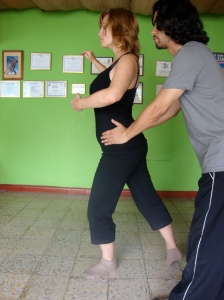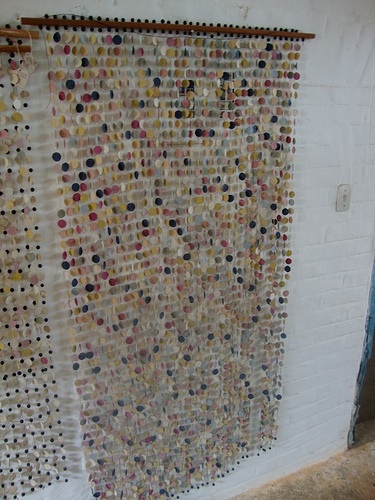 Tango feels like the passion I have been looking for a long time. It makes me happy. I don’t even need to be dancing. Watching others dance can be equally blissful. It’s the transportingly beautiful music, and most of all, the utter concentration and mindfulness that tango requires. If I am dancing, and my mind wanders just for a minute, my dance falters in a way that it is much more obvious than if my mind wanders while dancing salsa. I love the way that tango captures all of my attention. Even when I am watching others, I find myself completely focused watching them.
Tango feels like the passion I have been looking for a long time. It makes me happy. I don’t even need to be dancing. Watching others dance can be equally blissful. It’s the transportingly beautiful music, and most of all, the utter concentration and mindfulness that tango requires. If I am dancing, and my mind wanders just for a minute, my dance falters in a way that it is much more obvious than if my mind wanders while dancing salsa. I love the way that tango captures all of my attention. Even when I am watching others, I find myself completely focused watching them.
I have to admit that sometimes in my pre-tango life (funny how I could already say that, the pre-tango life. . . ) I felt a certain kind of despair. I would look at other people who have passions like ceramics or snow-shoeing that they really love. They get lost in the moment doing them, they know that they are going to enjoy a day if they spend it doing ceramics or snow-shoeing. I just couldn’t think of any one passion in my life where I would fairly reliably find joy.
How many Saturday afternoons did I spend shopping with a friend? Buying a new shirt might be sort of fun but it’s an expensive (and also cheap) form of joy. I’m not sure finding a great dress on sale qualifies as joy, more a thrill. Yoga, not really. I enjoy it for its emotional and physical benefits. Tennis is occasionally fun, but I can’t say that I care enough to work on my serve. Languages, yes, I love learning languages and that comes relatively easy for me. Writing is a need and it makes my life, mind and spirit infinitely richer. But I can’t say that writing consistently brings me joy. It also has brought me angst. So where is the joy in my life? That zone in my life where I lose track of time and become one with whatever I am doing, that gives me energy and uplift? I felt really sad when I didn’t know.
I was on the search for something that would give me joy at home this year while traveling. Traveling, I would say, is a joy. I get to be the amateur (for the love of it) sociologist that I naturally am, observing other cultures. But for most of this year, I felt like I was trying out a lot of things that I didn’t love enough to commit to, like scuba diving and surfing. I did a week of surfing lessons in Jericoacoara, Brazil. I enjoyed understanding the velocity of a wave and how one might try to ride it, but I wasn’t a natural and I thought, I just don’t care enough to spend a month of my life battling waves. I enjoyed watching surfers, especially the women, but just couldn’t imagine getting there myself. Ditto with capoeira: I like it, but would I ever get that good at it? I wondered, when am I ever going to find anything that I love enough to commit to it?
Patience. I think I finally found it. There were times when I really thought I was going to quit tango and give up, because the basics of the dance like the walk and the posture weren’t coming to me. But I stuck with it and found the right teachers and over time I gradually improved. There were also “big bang” improvements when suddenly the dance clicked. I am at the beginning of a lifelong learning curve, but over time I am loving tango more and more. The music. The dance. The blissful mindfulness of dancing and watching other people dance. And the people I have met through tango. I have learned some really important things by sticking with tango, even for just two months in Cali.
Now that I have finally found something that I actually love enough to commit to, I can see that it makes a big different to find the right fit. Maybe this is how people feel when they finally meet a lifelong mate. They realize that they were just trying too hard with all those others who weren’t the right fit. Now I can see that tango is a fit for me in a way that a lot of other things—most things, in fact—are just not.
For example, kitesurfing. While I was traveling I met tons of women who brimmed with energy and enthusiasm when they talked about kitesurfing, They talked about the adrenaline and I love adrenaline rushes, so I thought, I’m going to try this! Well, I did. I just couldn’t quite see it. It’s possible that I quit my lessons after one day because the water was way too cold at Lago Calima near Cali. But I kept thinking, for the cost of one hour of kitesurfing lessons I could do four hours of tango lessons!
Tango is a way better fit for me than kitessurfing. Tango is about connection and I enjoy feeling connection with others because I am such an interior person. Kitesurfing is totally solo and feels a little lonely to me. I am already lost in my own thoughts. Tango is a language, a communication between two people, and I enjoy languages. Tango has an endless depth to it in terms of styles and moves, and the depth of emotion expressed, both light and dark, and I like depth. Kitesurfing must have a lot of depth too but I just don’t care to learn it. Kitesurfing involves a lot of equipment and I hate dealing with equipment, it would be a chore to me to set up and take apart the kite every time. All you need for tango are proper dancing shoes and music. I love that.
Tango has really shown me that I have to find a lot of joy and bliss in an activity in order to want to pursue it. And that I feel a degree of passion for tango that I never felt for yoga, tennis, capoeira, or improv theater. (Though I am thinking improv theater might fall in the category of “if I had stuck with it longer, I might love it more, so I am going to try it again once I am settled somewhere.)
It brings me a feeling of peace to realize that there is at least one thing out there that I love enough to really commit to and learn deeply. In some way, understanding the qualities that bring my joy in tango helps me to understand how to bring more joy into my life with other things too. I’ve realized that my joy really comes through collective forms of music and dance–singing and dancing with other people. I am very much at the beginning with tango. It’s even possible this will be a passing fancy, though I hope not. Tango can be a lifelong love, and people usually get better as they get older. That is an exciting thought.



